
"On a long journey even a straw weighs
heavy" - Spanish proverb.
|
Way to loaded!
|
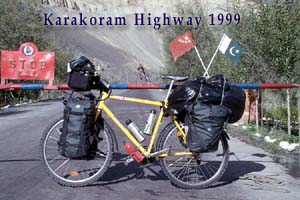 |
 |
I learned biking in Tibet the hard way. My first ever
touring trip was in central Tibet and I had no clue what so ever about that
I was about to do and just bought gear out of sheer leak of knowledge. Two important
lessons I have learned over the years are: 1) buy high quality, strong,
lightweight gear and 2) bring only the most necessary things along. The latter
seems obvious, but I know personally that one due to leak of knowledge tend
to bring gear for all worst-case scenarios. I dragged some 50 kg.on the Karakoram
Highway in 99' for a planned west Tibet trip and could probably not have withstood
weather conditions as I can now. The ironical thing is the fact that with my
knowledge today, I could easily have cut of 15 kg. (my bike setup weights around
33 kg for a trip on normal roads - very different when going off-road for real).
Weight might not be the biggest problem while cycling
in the long flat valleyes, but when going up passes or in difficult terrain,
going lightweight pays of! You know when you are on the right track when you
begin to measure weight in grams instead of kilos!
During the Keriya trip in 2002, I learned for real on
my body what lugging around with unnessary gear means. How many times didn't
I wish I could replace gear with food during that trip when I had 200 g food
pr. day during the last part...
Most comments on gear below are related to my last Tibet
trips and the gear mentioned is what I recommend bringing for normal roads in
Tibet during summertime unless something else mentioned. If going seriously
off-road or going in wintertime additional items and heavy duty equipment are
required. Some of the things mentioned below are not vital - like heavy cameragear.
However, my trips are not only focused on biking, that alone would quickly become
boring. I am addicted to photographing and its a heavy hatit to be burdened
with.
Some good gearlists:
Bicycle
My first bike for cycling in Tibet was a 30 $ mountain bike I bought in Lhasa
- not recommendable - I had nothing but problems with it! I have a TREK 8900,
a bike formerly with high-tec details which in many cases turned out too high-tec
and vunerable for Tibet conditions. However, I have done some 5 long tibettrip
on it and promised it a full retirement after crossing uninhabited Northern
Tibet with 35 kg. of food on the bike. Now I also have a On One-Steel frame
in stock as well.
- Frame: Alpha SL Double Butted 6061 T6
Aluminum. Try to buy a stell frame instead which can be welded if it
breaks - bend back if bend + the frame is more "stiff". As
said, I now also got a One One steel frame as well.
|
- Fork: Rock Shox Judy SL, 63mm. Has done
a very nice job - Aeroflot managed to bend it during the flight home
from Kathmandu in 2001, but my insurance paid another one. A suspension
fork is not a must for cycling in Tibet - it can easily be done without,
but has an advantage especially on bad washboard roads. Disadvantage:
expensive and heavy.
|
- Chainset : Icon
Crankshaft. 22-32-44 rings.
|
- Shifters: Shimano Deore XT Rapidfire
9 Speed. Generally, go for LX of XT. XTR is way too expensive and not
as durable as XT.
|
- Brakes: Shimano XT "V-brakes".
Performes very well. I have used Hydrolic disk brakes without problem,
but I want to keep things simple despite the fact it performed fantastic
on the long downhills. If any oil problems accured I wouldnt be able
to fix it in low-tec Tibet.
|
- Front derailletur: Shimano XT
|
- Rear derailletur: Shimano XT
|
- Cassette: 12-34, 9 speed. Some prefer
cycling with high-gearing setup. I cycle best up passes with a low-gear
setup.
|
- Saddle: Specialised "BG comfort
plus" My choice for the future, VERY comfortable! I used Selle
Italia, "Max Flite" before, but do NOT buy a competition saddle
like this, and do NOT start out on a long tour with a brand-new saddle.
I stood more up than sitting on the saddle during the first week of
cycling in West Tibet in 2001. Buy a comfortable one, test it before
take-off and keep the ability to get kids.
|
- Wheesl: I
mostly use 36-spokes Mavic 721 ceramic rims . Expensive, but the rim
walls wears down extremely slow! Have also used Sun 0'XC, 32 spokes
which did an acceptable job. I have used a Rolf Dolomite Disc wheelset
before, but the 24-spoke specialised downhill wheel had problems on
washboard roads combined with the weigh of gear -> spokes broke often.
Generally, go for 36 spokes on the wheels if possilbe.
|
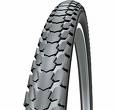 Tires:
Schwalbe Marathon XR 26 x 2.00. Highly recommendable! I very seldom
run into punctures with those tires. Disadvantage: They are heavy -
each tire weights some 850 grams. I once met a German cyclist who did
12.000 km without a puncture on the Marathon XR. I have used Continential
Goliath semislick tires across West Tibet and they performed badly.
The sidewall blew out on my backwhell and as goes for both of my bicycle
partner's tires. Tires:
Schwalbe Marathon XR 26 x 2.00. Highly recommendable! I very seldom
run into punctures with those tires. Disadvantage: They are heavy -
each tire weights some 850 grams. I once met a German cyclist who did
12.000 km without a puncture on the Marathon XR. I have used Continential
Goliath semislick tires across West Tibet and they performed badly.
The sidewall blew out on my backwhell and as goes for both of my bicycle
partner's tires. |
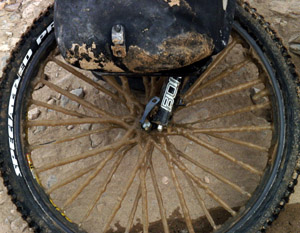 The
biggest problem of all on the West Tibet trip in 2001 was the breakdown of the
skew going through the backwheel. It broke off (!) when I attached the backwheel
again after fixing a spoke. Miraculous I managed to fix it by pure luck. A closer
inspection revealed that the screw also had been bend INSIDE the wheel, because
of the bumps on the road. I will bring an extra screw those days.
The
biggest problem of all on the West Tibet trip in 2001 was the breakdown of the
skew going through the backwheel. It broke off (!) when I attached the backwheel
again after fixing a spoke. Miraculous I managed to fix it by pure luck. A closer
inspection revealed that the screw also had been bend INSIDE the wheel, because
of the bumps on the road. I will bring an extra screw those days.
Bicycle Equipment
- Bicycle computer: Ciclomaster CM-414
bicycle computer with altimeter, temperature, road steepness,total altitude
gained througout day + more. Had some big problems making it work, because
the signal sender apparently has to be relatively close to the actual
computer itself. Apart from that, it worked very well. Stefan didn't
have a bicycle computer, didn't want one, but kept asking how long we
had gone... (still, do remember that most main roads got kilometer stones).
|
- Water bottles: I tend to use two or three
PET bottles nowadays(Pepsi/Cola etc) . Sometimes, if going in cold times
of the year I also bring a thermo bottle as well. Chinese thermo bottles
are normally bad in the sense they loose the heat quite fast.
|
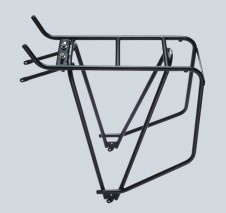 Rags/Carriers:
Tubus Cargo rear carrier (steel). Labled
40 kg. carring capacity. I tend to believe it as I have had no problems
it and consider it highly recommendable (540 g)! Delta Frontloader 2
made of alu and "specially" designed for front suspension
bikes is the worst piece of crap ever produced since the stoneage. It
completely broke apart and only repairing it with pieces of wood hindered
a complete breakdown. Do not buy this one. Buy racks of steel if possible!
I have the Tubus "Swing" (550 g) front suspension rack. It
performed exellent in northwest Tibet in year 2002 but I have had big
problems with it on a couple of trips now - broke apart different place.
Tubes has sent replacements but Im looking for another one now. That
one might become Old Man Mountain's Cold Springs carrier. Rags/Carriers:
Tubus Cargo rear carrier (steel). Labled
40 kg. carring capacity. I tend to believe it as I have had no problems
it and consider it highly recommendable (540 g)! Delta Frontloader 2
made of alu and "specially" designed for front suspension
bikes is the worst piece of crap ever produced since the stoneage. It
completely broke apart and only repairing it with pieces of wood hindered
a complete breakdown. Do not buy this one. Buy racks of steel if possible!
I have the Tubus "Swing" (550 g) front suspension rack. It
performed exellent in northwest Tibet in year 2002 but I have had big
problems with it on a couple of trips now - broke apart different place.
Tubes has sent replacements but Im looking for another one now. That
one might become Old Man Mountain's Cold Springs carrier. |
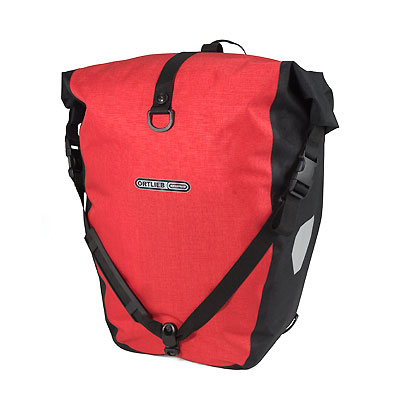 Bags/Panniers:
Two Ortlieb "Front Roller Light" waterproof
panniers, each 12 L (1250 g). Two Ortlieb "Back Roller Light" waterproof
rear panniers, each 20 L (1550 g). I used two sets of backroller in
2002 for carring more food and will do so again next time if going really
off-road. I have used Oritlieb during all my trip and can only recommend
them. Some minor problem: 1) their adapters to fit the bags to different
sizes of rag thickness have an annoing tendensy of falling off - use
tape to fasten them 2) their additional strap system is unnecessary
- leave it behind and just close the rolling system on the top of the
bag. Some say their "Basic" line is best and I liked their
solidness when I tried them. However, I stick to their "light"
line to save weight and they also perform excellent. I don't use a handlebar
bag - I have tried it and its surely very convenient especially for
camera gear, but the space in the bag is simply too small to justify
the extra 800 grams. I just carry the camera in a front painner instead. Bags/Panniers:
Two Ortlieb "Front Roller Light" waterproof
panniers, each 12 L (1250 g). Two Ortlieb "Back Roller Light" waterproof
rear panniers, each 20 L (1550 g). I used two sets of backroller in
2002 for carring more food and will do so again next time if going really
off-road. I have used Oritlieb during all my trip and can only recommend
them. Some minor problem: 1) their adapters to fit the bags to different
sizes of rag thickness have an annoing tendensy of falling off - use
tape to fasten them 2) their additional strap system is unnecessary
- leave it behind and just close the rolling system on the top of the
bag. Some say their "Basic" line is best and I liked their
solidness when I tried them. However, I stick to their "light"
line to save weight and they also perform excellent. I don't use a handlebar
bag - I have tried it and its surely very convenient especially for
camera gear, but the space in the bag is simply too small to justify
the extra 800 grams. I just carry the camera in a front painner instead.
|
- Carry bag: Sometimes I bring one - I
fx got a 250 g. carry bag. I have used Ortlieb "X-Plorer"
59 L waterproof stuff sack with padded straps for "trekking".
Placed on the top of the rear rack and mainly used for food storage
and tent poles and possible emergency situations in real off-road situations
which involves leaving bike behind. I used it while walking around Mt.
Kailash and from that experience I can only recommended it for short
walking trips without too much weight. (750 g.).
|
- Strap: Mountaineering strap for fastening
gear on the rear rack. In my opinion much better than elastic straps
(40 g).
|
| |
Tools
- Multitool 1: Toppeak "The Alien".
This multitool contains about everything a biker will need in handy.
Highly recommendable (250 g).
|
- Multitool 2: Leatherman "Wave"
multitool (210 g). Good, but heavy!
|
| |
-
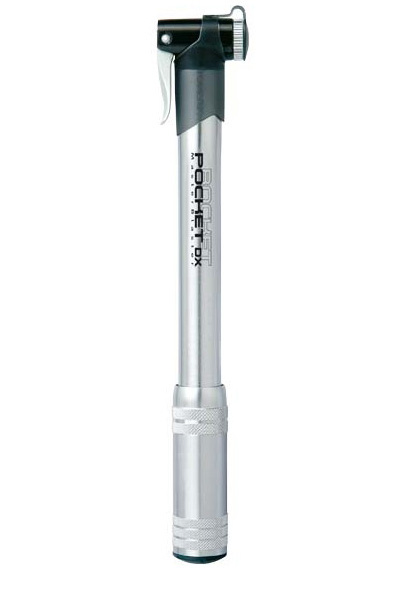 Bicycle
pump: Topeak Pocket Rocket. Small and expensive pump made of aluminium.
It's important to bring a STRONG bicycle pump which withstands whatever!!
I didn't do so during my Karakoram Highway trip and two tires were destroyed
when low airpressure made the tirewalls blow out! One also losses a
lot of energy riding on a partly flat bike. I have met other bikers
with the same pump problem. Bicycle
pump: Topeak Pocket Rocket. Small and expensive pump made of aluminium.
It's important to bring a STRONG bicycle pump which withstands whatever!!
I didn't do so during my Karakoram Highway trip and two tires were destroyed
when low airpressure made the tirewalls blow out! One also losses a
lot of energy riding on a partly flat bike. I have met other bikers
with the same pump problem.
|
- Teeth brush: Half of it cut away - for
cleaning difficult places.
|
- Cassette lockring remover. "NBT2
- the next best thing". needed for changing spokes next to the
casette.
|
- Shimano chain separator: The one I have
is build into the Toppeak tool.
|
Spare parts
- Gaffa tape: two metres. A must.
|
| |
- Bicycle tire: Schwalbe Maraton XR foldable
for long trip or just a thin foldable tire as backup if short trip.
|
- Inner tubes: two - sometimes one.
|
- Bolts: for front and rear rack repair.
|
- Brake pads: 4 - I use ceramic rims which
requires ceramic brake pads as well.
|
- Bicycle computer: cheap one, very annoing
if my only bicyclecomputer cracks!!
|
- Spokes: different length + nipples. Front
and back whell don't have the same length. 12 spokes.
|
| |
| |
- Oil: "Cross Country" 'wet'
(120 ml). It lasts forever. In 2001, I took three 120 ml bottles with
me, but one would have lasted all the way from Kashgar to Kunming (5200
km) alone! Don't use dry oil if going rainy season.
|
- Ball bearings: for pedals and headset.
|
| |
| |
- Metal wire: 2 meters. A must for impossible
repairs.
|
- Inner screw, going through wheel.
|
| |
Mischellaneous Equipment
- Rope: I'll use the wind stabilisation
rope from the tent.
|
- Wire lock: I use a small one or none.
In Tibet I'm mostly worried about people trying to steal something from
my panniers - but this risk is surely lower than in other places (120
g).
|
- Small bags: Set of Tatonka small bags
for trying to organise something out of the mess (5 bags).
|
- Head torch: Petzl MYO XP. Works on two
AA batteries (190 g with batteries) .
|
- MP3 Player. Iaudio G3, 2GB flash player - some 40
hours on one AA battery. Please note that several cylists in Tibet have
had problems with their Ipod harddisk players - they stop working in
altitude!
|
 GPS:
"Garmin GPSmap 60CSx" with compas and altitude profile. (Incl 2
AA batteries and bag). Not really needed on main roads, but nice to
have + a must if going off-road for real (210 g). GPS:
"Garmin GPSmap 60CSx" with compas and altitude profile. (Incl 2
AA batteries and bag). Not really needed on main roads, but nice to
have + a must if going off-road for real (210 g). |
- Batteries: 5 AA Alkaline I once wanted
to bring superlight and cold resistant Lithium batteries with me, but
learned they don't last longer for small power consuming devises like
the MP3 player + they are highly expencive (100 g). Use it for my GPS
though.
|
- Peber spray! Not necessary while cycling on normal roads (use
stones for mad dogs) - just scared to meet a hungry Tibetan bear or
wolfs in Northernmost Tibet :)
|
Camera
- Camera: Canon 5D. Supergood camera but
very expensive.
|
- Lenses: One 16-35 mm F 2.8 Canon lens
and one Canon 70-300 mm. lens
|
- Filters: I use polariser filters. Skylight
filter is a good alternative.
|
- Tripod: 140 cm tripod. Cheap and supercompact
Chinese version. Sometimes I bring it with me. Perfect for adding more
dept into the photos or nightshots of stars. Minitripod or ski pole
with build-in camera attachment has turned out being bad solutions
|
- Films: None any more!! This alone save
me up to 2 kg. Instead I got 2 x 8 gb compact flash cards.
|
- Batteries: One spare battery + adapter.
|
- Photo bag: Used a Ortlieb waterprof photo
bag before - difficult to access and the waterproffness not nessary
in the waterproff panniers. I just use my old photobag and save some
100 g (125 g) I have gone without photo bag a few times, but its too
rough for the camera.
|
Camcorder
- Camcorder: Sony HDCR 1 highdefinition videcamera - lightweight.
I sometimes bring it along.
|
| |
- Battery: Extra battery, (250 g)
|
- DV tapes: 6 Sony 63 min tapes for HD-camera(220 g)
|
| |
Cooking Equipment/Water/Food
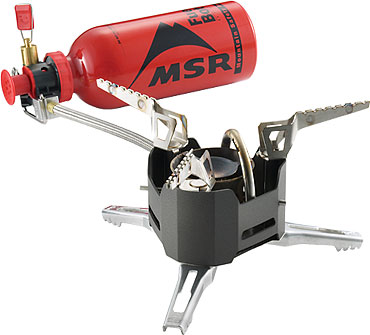 Stove:
MSR XGK Expedition - even yak dung (500 g)? I
nearly ended up doing prayers and prostrations each time I wanted to
turn on my Primus "Multi fuel Stove" in 2001. Cleaned it a bunch of
times but nothing helped. In year 2002 I went with a MSR XGK which should
be the best expedition stove on the market. Yet, it spoiled a summit
attempt on Mt. Mustagh Ata and I was forced to clean it about every
second day on the Kerriya Shankou trip, and was course to frequent frustrations
and late departures. Janne's XGK stove performed well with the same
fuel and I suspect I just had bad luck with the one I bought in Kathmandu.
I have another one now and it performs perfect EXCEPT for the pump.
I have had so many problems with it since they changed the pump cup
from leather to rubber. It comes of constantly. Heard the same story
from other cyclists as well. Gas stoves are too complicated for ordinary
cycling. Stove:
MSR XGK Expedition - even yak dung (500 g)? I
nearly ended up doing prayers and prostrations each time I wanted to
turn on my Primus "Multi fuel Stove" in 2001. Cleaned it a bunch of
times but nothing helped. In year 2002 I went with a MSR XGK which should
be the best expedition stove on the market. Yet, it spoiled a summit
attempt on Mt. Mustagh Ata and I was forced to clean it about every
second day on the Kerriya Shankou trip, and was course to frequent frustrations
and late departures. Janne's XGK stove performed well with the same
fuel and I suspect I just had bad luck with the one I bought in Kathmandu.
I have another one now and it performs perfect EXCEPT for the pump.
I have had so many problems with it since they changed the pump cup
from leather to rubber. It comes of constantly. Heard the same story
from other cyclists as well. Gas stoves are too complicated for ordinary
cycling. |
- Wind shild: . For stove. Saves some
25% fuel.
|
- Fuel bottle: 0.95 L MSR bottle. A 2/3
L bottle is sufficient on normal roads. I use a soft drink bottle in
case I need to carry more. Make sure it does not leak in the bicycle
pannier!!!
|
| |
- Cooking pot: 2 L titanium with lid (195
g). Important to bring a big pot if going at a time of the year where
it's nessary to melt snow or ice.
|
- Cup: 0.9 L (145 g). Also titanium. Superlight,
cheap and durable cups and pots can be found in nearly every Chinese
supermarket.
|
- Lighters: Three placed in different bags.
Bring some from home and none with electric firestarters!!! Most Chinese
lighters are bad - difficult to find anyone without electric firestarters.
|
- Spoon: Forget the fork - not necessary.
|
- Water cleaning: Vital consideration!! I normally get water
from restaurants or use Micropoor Forte pills. Do notice two hours is
needed to kill Girardia.. Take a look at this
link
on watertreatment and this
one as well. I have used MSR MiniWorks water filter, a nice
well-functioning filter, but its just too heavy and bulky for me. Clean
your water in Tibet carefully. If you get Giardia, which in some versions
give strong!! persisting diarrhea, your trip will be no fun. Drink as
usual as much as you can in altitude and more. Tasty "Jian Li Bao"
soft drinks can be bought even in small villages along most roads. Important
with water carrying capacity for up to two days while being on roads
as water can be scarce some places (e.g. Aksai Chin) depending on the
time of the year.
|
- Water bag: 10 L Ortlieb (120 g). For back- and off-road adventure
or alternatively a 4 L bag
|
- Multivitamins: The food is mostly instant
noodles.
|
Not to forget. I also bring 5 kg of extra body fat with
me. It's not handy here, but it is in Tibet.
Camp
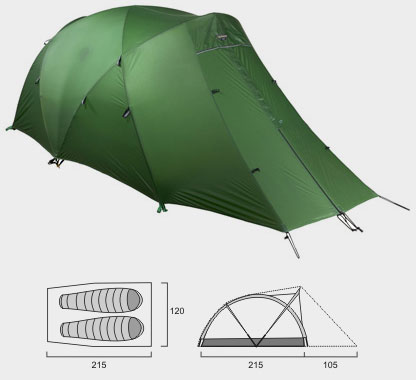 Tent:
I now use Lightwave F2 - a light 4-pole geodesic selfstanding mountain
tent which weights 2.6 kg. A bit heavy, but ideal in strong wind and
if going for mountaineering along cycling. It's wilderness green colour
is perfect for hidding out. Two major complains! 1: A mountain tent
dont have massive areas of ventilation fabrics - I had a Chinese tent
producer sewing fabrics to cover those areas where the wind could pass
right through 2: The tent poles are extremely difficult to force though
the tent pole tubes when setting up the tent - takes forever - they
are way too narrow!! Tent:
I now use Lightwave F2 - a light 4-pole geodesic selfstanding mountain
tent which weights 2.6 kg. A bit heavy, but ideal in strong wind and
if going for mountaineering along cycling. It's wilderness green colour
is perfect for hidding out. Two major complains! 1: A mountain tent
dont have massive areas of ventilation fabrics - I had a Chinese tent
producer sewing fabrics to cover those areas where the wind could pass
right through 2: The tent poles are extremely difficult to force though
the tent pole tubes when setting up the tent - takes forever - they
are way too narrow!!- I have formerly used Terra Nova "Voyager" tent,
green (2400 g) four-seasons ten, selfstanding, very wind stable. I cut
the mosquito net and serveal other unnessary details off in weight fanatism.
The Voyager works well, except for the zippers which gave up completely
in 2002. Terra Nova fixed it for free. Ground sheet for tent is heavy
and unnecessary. Generally, bring a windstable and superlight tent.
- For heavy mountaineering and cycling I have
Mountain Hardware "Annapurna". Crossed Tibet's Chang Tang
with it - very recommendable tent. Neg: screaming color + it witghts
3,5 kg.
|
- Sleeping pad: Term A Rest "Ultralite"
(650 g). It's also possible to get a 3/4 version of this inflatable
air mattress and save some 220 grams, but I prefer the comfort of this
one. Foam pads are simply too voluminous for cycling.
|
- Sleeping bag: Mountain Equipment "Classic
1000" down sleeping bag (1750 g), comfort temp. - 20 C. No sleep - no
biking fun. Don't compromise on sleeping bag! I used a Marmot "Cwm"
rated down to - 40 C during the Kerriya Shankou trip in september and
was actually freezing at night when the sleeping bag was a bit wet from
moisture and because of my rapid weight loss. Normally, a -10 C comfort
temperature bag should do the trick during a summertrip in Central Tibet.
|
- Compression bag: for sleeping bag - a
must.
|
- Repair kit for Term-A-Rest
|
Cloth
The sun in Tibet is incredible strong due to altitude
and location. Sun protection is important if you don't intend to end up with
Tibetan leather skin. Use cloth to cover as much skin as possilbe and use sunblock
for the exposed places. The weather in Tibet often change abrupt from sun to
rain, hail or snowstorms especially while crossing passes, but can be very hot
while cycling in valleys or even at 5000 meters plateaus e.g. in Chinese Kashmir.
| HEAD |
- Cap: Lowe Flapped Hat. Covers also the
neck against the sun (Important!). Works really well, but I look like
a bumb with it (100 g). Helmet - I don't fell comfortable using a bicycle
helmet. Also, I dont want to look fancy while cycling in Tibet. Instead
I go slow downhill the passes nowadays.
|
- GoreTex Cap. With fleece inside.
|
- Sunglasses: Mountaineering style to add
over glasses.
|
- Spare glasses: I'm next to blind without
my glasses. I will be in deep trouble if they are destroyed. Contact
lenses is too complicated for me in Tibet (dust problems and weight
of contact lens cleaning solution).
|
| FEETS |
- Boots: La Sportiva "Tibet" Gore-Tex boots
(size 45) (1400 g). I loved them in year 2001 - now I hate them. They
were sucking wet during the Kerriya Shankou trip probably because the
GoreTex membram broke. These ones have to be replaced before next trip.
I am going for trekking boots again, as it works really good for me
even while cycling. Unfortuantely, not everyone feels comfortable cycling
with boots. I have been carried sandals
during the last two Tibet trips. After some considerations - I don't
bring them next time - good for rivercrossings, but to heavy and bulky
to carry. I'll bring waterproff socks instead for cold stony glacier
rivers. SPD-shoes sucks - at least for me. A Japanese sent the
one I used in west Tibet home for me from Lhasa and I ended up using
trekking boots instead.
|
- Socks: Two pairs of thin socks (on pair
of them are waterproof) and two pairs of thick socks (not cotton!) Had
to dry my only pair of thick socks over my stove every morning in the
wet part of the Kerriya trip. That ended up in socks with loads
of holes! Never going with only one pair of thick socks again!
|
- Gaiters: For off-road adventures which
involves snow.
|
| HANDS |
- Gloves: waterproof for rain and cold
weather: Lowe Alpine " Dr. Strangelove" with inner fleece gloves which
can be taken out (300 g). There are better choices than these mountaineering
gloves.
|
- Riding gloves: Buy some with long fingers
and covered backside against the sun.
|
| UPPER PART OF BODY |
- Shell jacket: The North Face XCR Gore-Tex
Jacket - don't know the name of it, bought cheaply in Beijing - not
fake (750 g). My old THF Kitchatna leaked on arm parts and the gluing
on the back gave up and as did the zipper. The shop where I bought the
jacket gave a full refund payment after three years of use.
|
- Fleece Jacket: Mountain Hardware "200".Don't
bring a windstopper jacket - breathing ability is considerably reduced
compared with normal fleece (500 g). I also bring a Mountain Hardware
"100" fleece jacket. I have used a "300" fleece
jacket alone before, but got the two Mountain Hardware very chap in
Beijing which makes it easier to dress according to weather conditions.
|
- Long sleeve shirt for cycling: Helly
Hansen expedition shirt. Cotton absorbs moisture instead of transporting
it out to the next layer -> avoid cotton!
|
- Normal shirt: For civiliation.
|
| LOWER PART OF BODY |
- Rain pants: Free Style GoreTex. Remember
if get a pair which got zippers the whole way up the legs. The zipper
on my old rain pants only went halfway up and I had to take off my boots
every time I took them on - very annoing.
|
- Pants: Used for cycling as well for everyday
life.
|
- Cycling shorts: Giordana, one pair -
used under the pants. Tibetans will look upon you as coming from outer
space if you use cycling shorts alone.
|
- Long expedition underwear: I bring it
sometimes agains cold weather conditions.
|
- Normal underwear: two pairs.
|
Hygiene
- Small towel: Thin and 40x30 cm, made
of microfibre.
|
- Lipsticks with sunblock: (F9). Sunblock
can also be used.
|
| |
| |
- Shaving gear: use soap for shaving.
|
- Sun lotion: factor 50, 50 gram.
|
| |
| |
- Polishing cloth: for glasses and camera
lens.
|
| |
Medicine:
Disclaimer: I'm certainly not an expert on medical needs.
Below is what I bring and is only a suggestion list. Please consult your doctor
for your specific needs. However, I STRONGLY recommend Himalaya bikers to read
up on symtoms and treatment of altitude
illnesses . This matter should NOT be taken lightly. Some years ago, according
to what I heard, it killed a Japanese cyclist in West Tibet. I don't know if
its true, but it CAN happen when cycling up to the Tibetan plateau ignoring
symptoms of altitude problems.Wise to take a restday while cycling up to the
plateau to adapt better to altitude. In doubt of problems, take a restday at
the altitude you are at OR if symptoms are strong - get down into lower altitude!!
Update 2007: Last year I met a russian cyclist in Ali who had been in coma for
4 days in his tent due to altitude sickness. He is lucky to be alive today!!
Remember to take the necessary vaccinations - its plain
stupid not to. Ask your doctor for details. One of my big concerns in Tibet
has been the risk of Rabies if bitten by one of huge amount of wild dogs there.
I'm not vaccined against it as it costs a fortune and only extends the amount
of time one got before going through threatment if a fatal outcome is
to be avoided. The vaccine has to be stored a cool place and is useless if dumped
into a bicycle pannier. Don't panic if bitten - there is only small risk of
Rabies - still, do seek medical help.
- First aid package: Plaster, disinfecting,
and bindings.
|
- Sports tape: If feets starts falling
apart.
|
- Flagyl:1 package of 200 mg. tablets,
2 packages of 400 mg. tablets. To fight Giardia
which is very common in Tibet. I usually take a 2000 mg. one-day dosage
to kill the beast -> no cycling for at least one day as it knocks
you completely out. A friend of mine got persisting very strong diarrhea
from Giadia in Tibet in 98' which destroyed his whole trip. Don't go
without something to fight Giardia!!
|
- Painkillers: Soft Asprin and some Chinese
"cannot fell my legs" ones...
|
- Diamox: Against altitude sickness. Very
important NOT to view this one as the ticket for fast ascent!!
|
- Ciproxin: Antibiotic against diarrhea
with fever.
|
| |
- Immodium. To stop diarrhea. Its a problem
to use it because you get the diarrhea to get rid of bad bacterias.
|
- Dulcolax: Opposite. Makes your stomac
works "faster".
|
- Bentasil: Against sore throat. I didn't
need them in Tibet, but in polluted Kathmandu I did!
|
- Malarone: (250 mg) against Malaria. There
is no Malaria in Tibet, but if I get it outside Tibet and become sick
in Tibet, I will be in deep trouble if I cannot deal with it.
|
Documents and money
- Vaccination card. Most
of it cut away to save weight.
|
| |
- Small vallet:
for everyday payments. You don't need to show everyone all your money.
|
| |
| |
| |
- VISA card/Master card. Danish
banks sucks on this matter. Danish credit cards got some very regid
rules on maximum amount of money drawn per day!
|
| |
- Photocopies: of important documents.
|
Info.
| |
- Maps! 1) The Tibetan part of the Chinese truckdriver's atlas
with kilometers between cities included. 2) Map
in 1:2.000.000 scale of Tibet (Geocenter). A bit unaccurate, but gives
a nice overview of Tibet with European city names 3) Chinese map over
Tibet, bought in the bookshop in the Lufthansa Shopping Centre in Beijing.
Really good and amazingly accurate on roads. 4) TPC American military
fly navigation maps of the part of Tibet I'm going. 1:500.000. Good
for GPS navigation. Not a must for normal road cycling, but I'm a map
lover....Generally - EVERYTHING unnecessary have been cut off the maps.
|
- Frasebook: Mandarin (Chinese) from Lonely
Planet. Bring a Chinese frasebook along - it makes life much easier
for you and cracks down personal and cultural walls. I have had the
Tibetan version with me before, but I seldom used it -> cut away.
|
- Dairy/notebook Very compact with huge
amount of lines on each page.
|
| |
- Writing pens: Be carefull - the low pressue
at 4500 - 5000 meters in Tibet cause most pens to leak all over.
|
- Waterproff bag: For maps.
|
List of things I have carried with
me, but will leave at home next time.
In general, I cut away all parts of my gear I consider unnessary - Brand names,
moskito net in tent, parts of maps, books ect. This has saved me for kilos!
However, the best way to save weight is to only bring necessary things.
2002: Water filter, 10 film, emergency whistle, some
maps, minerals, overboots, sandals, 2 straps, watercontainer, power supply for
camcorder. 120 ml oil.......
2001: Most cut away after trip was for an advanced Everest
trek I didn't do; overboots, neckband, ski pole
(very useful, but I have become a weight fanatic), ice axe (actually good for
making campsite), crampons, SPD-shoes, bicycle pants (1), upper and lower termal
underwear (3 pieces), socks (1), 1000 g. of small things, 120 ml wet oil, fleece
gloves, ground sheet for tent.
/Martin




 The
biggest problem of all on the West Tibet trip in 2001 was the breakdown of the
skew going through the backwheel. It broke off (!) when I attached the backwheel
again after fixing a spoke. Miraculous I managed to fix it by pure luck. A closer
inspection revealed that the screw also had been bend INSIDE the wheel, because
of the bumps on the road. I will bring an extra screw those days.
The
biggest problem of all on the West Tibet trip in 2001 was the breakdown of the
skew going through the backwheel. It broke off (!) when I attached the backwheel
again after fixing a spoke. Miraculous I managed to fix it by pure luck. A closer
inspection revealed that the screw also had been bend INSIDE the wheel, because
of the bumps on the road. I will bring an extra screw those days.